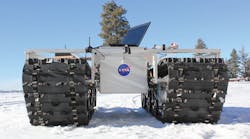NASA Technology Homes In On Glacial Changes
One key barometer within the climate change debate is the melting of ice in glacier-dominated regions, such as Greenland and Antarctica. The United States National Aeronautics and Space Administration (NASA) applies the scientific method to this controversy, using two technology approaches to measure glacial changes occurring in these areas. The first involves two satellites, which help pinpoint glaciers’ role in sea-level rise. The second is a robot that will roam over Greenland’s landscape to detect changes in the ice sheet.
Using satellites, a new study of glaciers worldwide compares traditional ground measurements to satellite data from NASA’s Ice, Cloud, and Land Elevation Satellite (ICESat) and Gravity Recovery and Climate Experiment (GRACE) missions. The study, which estimates ice loss for glaciers in all regions of the planet, spans from 2003 to 2009 (when the two missions overlapped).
ICESat stopped operating in 2009. It measured glacier change through laser altimetry, which bounces laser pulses off the ice surface to inform the satellite of changes in the height of the ice cover. A successor, ICESat-2, is scheduled to launch in 2016. GRACE is still operational; it detects variations in the Earth’s gravity field resulting from changes in the planet’s mass distribution, including ice displacements.
Overall results of the study show that glaciers outside of the Greenland and Antarctic ice sheets, which constitute 1% of all land ice, lost an average of 571 trillion pounds of mass every year during the six-year study period. Thus, the oceans rose 0.03 in. per year, equating to about 30% of the total observed global sea-level rise during this period. Antarctica’s peripheral glaciers (small ice bodies not connected to the main ice sheet) contributed little to sea-level rise during that timeframe.
The analysis builds on a 2012 study using only GRACE data, which also found glacier ice loss was less than estimates derived from ground-based measurements. According to the study, though GRACE has inadequate resolution and ICESat lacks sufficient sampling density to study small glaciers, the two satellites’ estimates of mass change for large glaciered regions agree well.
A prototype of GROVER, minus its solar panels, was tested in January 2012 at a ski resort in Idaho. The solar-powered robot will roam Greenland’s massive ice sheet. The laptop shown is for testing purposes only. (Courtesy of Gabriel Trisca, Boise State University.)
Moving beyond satellites, NASA recently took its study of changes in ice sheets to the ground with its newest scientific rover—the Greenland Rover, or Goddard Remotely Operated Vehicle for Exploration and Research (GROVER; see photos). The autonomous, solar-powered robot carries a ground-penetrating radar (GPR) to study how snow accumulates and adds layer upon layer to the ice sheet over time. One side benefit is that this type of research costs less than aircraft or satellites. Testing ran from May 3 through June 8.
The tank-like GROVER stands six feet tall (including solar panels) and weighs about 800 lbs. It traverses the ice on two repurposed snowmobile tracks. A GPR powered by two rechargeable batteries rests on the back of the rover. The radar sends radio wave pulses into the ice sheet, and the waves bounce off buried features.
From the Summit Camp research station operated by the National Science Foundation (NSF), where the ice sheet is about two miles thick, GROVER crawled at an average speed of 1.2 mph. The research team communicated with it via Wi-Fi within a three-mile range. GROVER transmitted snippets of data to ensure that it was working properly, but most of the data will be recovered now that the testing has been completed. The team planned to eventually switch to satellite communications, allowing the robot to roam farther and transmit data in real time.
The hope is that more radar data will help shed light on Greenland’s snow accumulation. Annual accumulation is compared to the volume of ice lost to sea each year to calculate the ice sheet’s overall mass balance and its contribution to sea-level rise.


